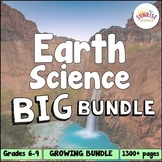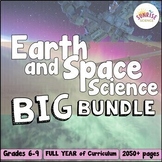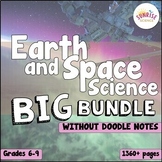Weather Unit Atmosphere Fronts Air Masses Storms High and Low Pressure Clouds
- PDF
- Google Apps™
- Internet Activities

Also included in
- Looking for fun, student-centered, and engaging activities to add into your Earth Science curriculum? This is all of my resources for teaching Earth Science! This is a bundle of engaging resources including editable NGSS-aligned blended learning units, Cornell Doodle Notes, digital Pixel Art contentPrice $223.00Original Price $316.63Save $93.63
- This is a bundle of all of my resources for teaching Earth and Space Science at the middle school level! These resources include a mix of Cornell Doodle Notes, lab activities, inquiry activities, digital lessons and units, projects, and pixel art digital content review activities.✨ Please note thatPrice $327.00Original Price $450.24Save $123.24
- Looking for fun, student-centered, and engaging activities to teach about Weather and the Atmosphere? This unit covers the weather variables of air temperature, air pressure, humidity and relative humidity, dew point, precipitation, wind, air masses, weather fronts, and high and low pressure systemsPrice $36.00Original Price $44.80Save $8.80
- This is a bundle of all of my resources for teaching Earth and Space Science at the middle school level, EXCLUDING the Cornell Doodle Notes. The resources in this bundle include a mix of digital lessons and units, lab activities, inquiry activities, projects, review activities, and assessments.✨ ThiPrice $259.00Original Price $369.00Save $110.00
Description
This 4-week blended learning unit on Weather and the Atmosphere is a series of lessons help students understand how air pressure is affected by altitude and changing temperature of air in the atmosphere, why the Earth has weather and how conditions of the atmosphere change with the unequal heating of the Earth, how temperature, humidity, wind speed and direction, and precipitation affect local weather, and the concept of air masses and weather fronts. This unit is full of engaging phenomena, demonstrations, opportunities for modeling, virtual simulations and interactives, graphic organizers, data analysis, discussion, and fun!
What is a blended learning unit? Blended learning combines online educational materials and opportunities with physical place-based classroom methods. This resource is the digital 'backbone' component of the unit that is editable and flexible for incorporating hands-on activities and labs and for varying the delivery of lessons to accommodate whole-class discussion, or small group, partner, or individual work.
But PLEASE NOTE! This is NOT a "webquest"! These lessons are written to be a sequential journey through the content and the teacher will still be facilitating the lessons. Students are not left to complete these lessons on their own. The teacher can use best practice pedagogy to have students interacting in whole-class discussions and small group work throughout the unit!
These 11 lessons are organized into separate Google Docs that you can share each day (or every other day as some lessons will take 2 or 3 class periods) on your Google Classroom. Students will type directly on their copies of these Docs and these are what you will grade for each student.
My students have responded so well to this lesson format. I love that I can schedule out all of the lessons in Google Classroom and I know what I’m teaching weeks out! The prep is easy and the grading is so easy too.
This download includes a Unit Overview Google Doc that is for the Teacher. This document has all of the lessons written out in sections (Lesson 1, Lesson 2, Lesson 3, etc.) so that you can see everything in one place. This document notes how many days (45 minute periods) each individual lesson will usually take to complete and it contains most of the answers for the activities. This will help you with planning. It also contains the answers and example student models.
Please view the PREVIEW for more visuals of how this unit is organized.
This unit was designed to satisfy the following NGSS Standard: MS-ESS2-5: Collect data to provide evidence for how the motions and complex interactions of air masses results in changes in weather conditions.
This is a list of the topics/concepts covered in each lesson:
Lesson 1: intro to weather, unit phenomenon (hailstorms)
Lesson 2: hailstones, weather data analysis
Lesson 3: relative humidity, wind, wind chill
Lesson 4: taking measurements of temperature, humidity, wind speed and direction, precipitation
Lesson 5: unequal heating of Earth, layers of Earth's atmosphere
Lesson 6: troposphere temperature, differences in surface temperature, cloud formation
Lesson 7: atmospheric air pressure, temperature and air pressure, local winds (sea breeze, land breeze)
Lesson 8: high and low pressure systems, isobars, simple weather prediction
Lesson 9: air masses and weather fronts
Lesson 10: types of precipitation, conditions for storms
Lesson 11: cumulonimbus clouds, hailstone formation, conditions for hailstorms
Throughout this unit, students will engage in:
- modeling activities and feedback galleries
- digital manipulatives and graphic organizers
- virtual interactives and simulations
- predicting, observing, and explaining phenomena from demonstrations
- video clips
- readings
- data analysis
- formative assessments
- post assessment
- ... and more!
This unit took me months to plan and it has been completed by my students! They loved it and I had so much fun teaching it! I'm confident that this unit will save you TONS of planning time! You will have 4 weeks of editable and flexible curriculum.
You may also be interested in these related resources:
Weather Variables Cornell Doodle Notes
Weather Systems Cornell Doodle Notes
Weather and the Atmosphere Unit Bundle
You can also take advantage of a HUGE discount off of this and all of the resources in the Earth & Space Science BIG Bundle!
Thanks for looking!
Sunrise Science









